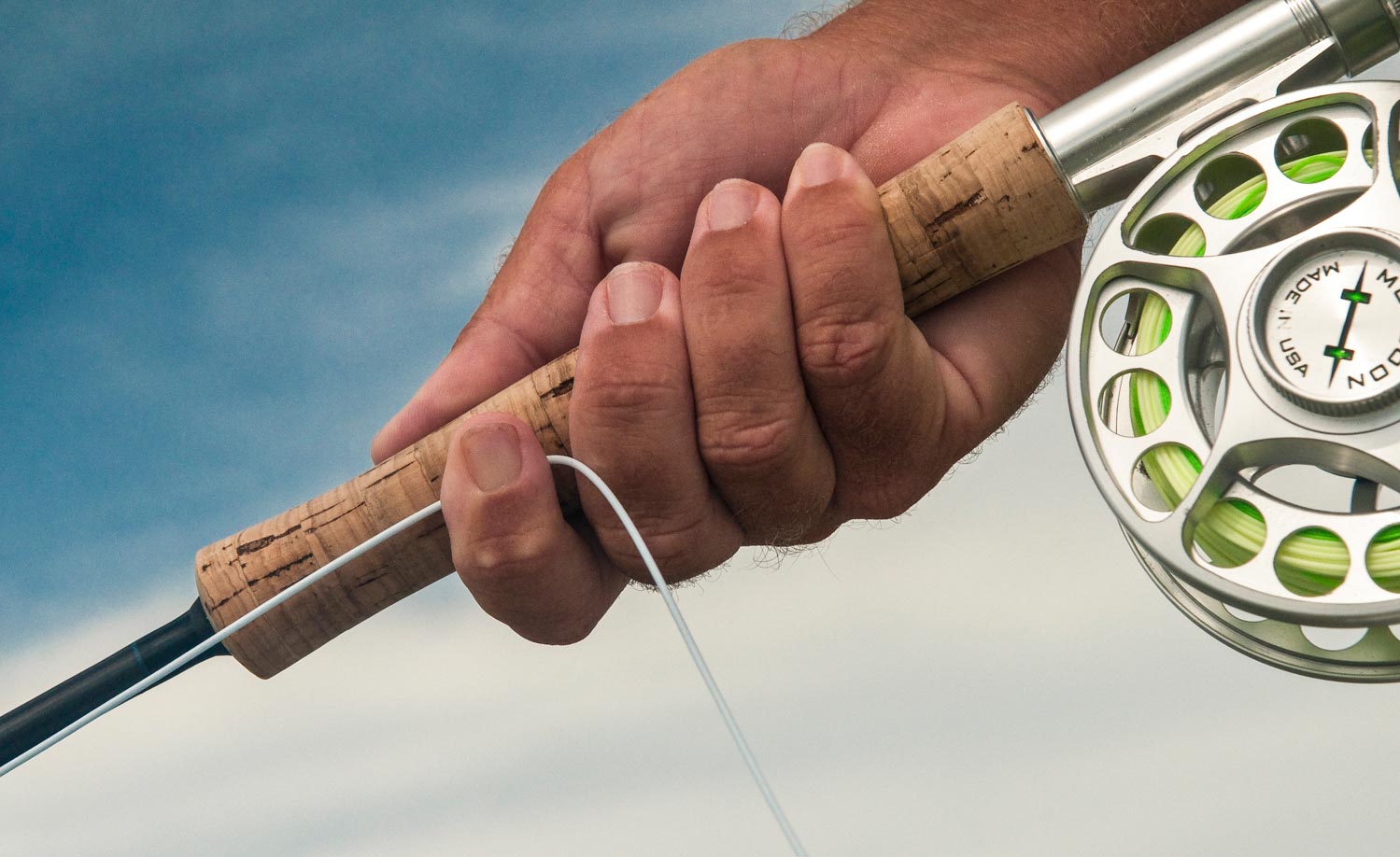By Louis Cahill
Picture yourself grasping a broomstick and driving in a tack with your thumb.
I get the opportunity to work with a lot of anglers who are making the transition from freshwater fly fishing to saltwater. Not surprisingly, most of them struggle with generating the casting power needed to deliver a good presentation in the kind of wind often experienced in flats fishing. Almost everyone has the same pesky problem. They try to generate a more powerful cast and everything breaks down. The problem is not in their arm or elbow or wrist, but in their head.
It’s a problem of understanding the mechanics of the cast. It seems logical to think that more power in means more power out and I guess that’s true but there is a common misconception about where that power is coming from. Most anglers, when trying to add power to a cast, focus on the fly or the line. They visualize throwing that line to the target. The result is a casting stroke that resembles a pitcher throwing a baseball. Including the wind up in the worst cases.
This imagined model of throwing a static object puts all the wrong physics in play for a good fly cast. The resulting casting stroke relies too heavily on the arm and takes the rod out of play. Our instinct tells us to throw harder but the arm is a poor tool for throwing a fly line and our cast fails. The answer to a powerful fly cast is timing and technique, not power.
I’m going to give you a simple tool to help generate a powerful cast but first let’s look at the mechanics.
The fly cast is all about the transfer of energy from our hand to the line. An energized fly line will cut the wind, deliver a fly with accuracy and will not tangle. The tool we use to energize the line is a fly rod. Think of the rod as a guitar amplifier. The physics of how they work is surprisingly similar. There is an inherent energy stored in the fly rod. We use that energy (the flex of the rod) to amplify the signal from our hand and translate it to a wave form which is stored in the line (the loop).
So in this model the signal is initiated by the hand, amplified by the rod and the resulting wave is the loop in our line. If we want to play louder we have two options. Volume and gain. What most of us do when we try to add power to a cast is turn up the gain. This is like putting an overdrive pedal between the guitar and amplifier. The sound is louder, but badly distorted. Great for metal, bad for fly fishing. If you haven’t guessed, that overdrive pedal is your arm. Trying to add power to the cast using your arm results in a distorted signal which means a sloppy deformed loop. No real power.
To get a clean powerful signal we want to use the natural power of our amplifier. The fly rod. The force that energizes the line is the natural energy of the rod. It’s recovery from a flexed position to a relaxed position. That flex is what we call the load. The more flex, the deeper the load. The deeper the load, the more power is stored in the line. By keeping our arm motion under control and using the load of the rod we are able to deliver both power and control.
I can geek out about the physics of fly casting a lot further but I’ll spare you. Here’s what you need to know.
 It’s all about focus. Martial artists control the complex mechanics of their form through focus. They use meditation as a tool to isolate and concentrate on key points of the body’s complicated systems. When energy is focused on these points, the rest of the system falls in line. The same idea applies to fly casting and, with a thumb-on-top grip, the point we should be focusing on is the thumb.
It’s all about focus. Martial artists control the complex mechanics of their form through focus. They use meditation as a tool to isolate and concentrate on key points of the body’s complicated systems. When energy is focused on these points, the rest of the system falls in line. The same idea applies to fly casting and, with a thumb-on-top grip, the point we should be focusing on is the thumb.
I’m not suggesting that you sit in a lotus position, thinking about your cast while your buddy whacks you with a 10 weight but some simple visual exercises can make a real difference in your casting.
Picture yourself grasping a broomstick and driving in a tack with your thumb. Imagine that you are stepping on the bristles of the broom so it can’t move. You want the pressure to be smooth and controlled so the tack goes in straight. As you press the tack in, squeeze with your pinky to use the leverage of your hand. Picture it very slowly at first, then faster until you’re driving that tack like a nail gun.
I like this metaphor because it reinforces a good straight line rod path which will make a tight loop. Remember, your thumb is the focus point. It’s like the foot on the accelerator. When you feel the line straighten and its weight start to load the rod, focus on the thumb and drive the cast like you’d drive that tack. You’ll like the results.
Timing is also crucial to a good cast. I’d recommend that you check out Capt. Joel Dickey’s line speed drill (HERE) and practice it as well. You’ll be amazed at how much power you can add to your cast and whether you’re fishing in freshwater or salt, a better cast usually means more fish.
Louis Cahill Gink & Gasoline www.ginkandgasoline.com hookups@ginkandgasoline.com Sign Up For Our Weekly Newsletter!

Joe Humphreys has taught this technique for years. Watch any Joe Humphreys video to see him demonstrate “the squeeze.” This will tighten your loops, cure your tailing loop, and allow you to punch your fly in tight brushy places. It will also give you the George Harvey slack leader cast and the tuck cast when using split shot.
Joan Wulff demonstrates the grip and squeeze, and power of the thumb in her video: “The Dynamics of Fly Casting.” Easily one of the best instructional videos out there.
Joe Humphreys and Joan Wulff. It seems I’m in pretty good company. Squeezing of the cast is a time tested technique. I am concerned that you guys are missing the point. The mental focus aspect of this is key. Being mindful of the thumb yields big benefits. It also help you employ the same technique when you use a V-grip cast.
Good stuff Louis, focus is the key no doubt. Thanks
Pingback: How To Get High Line Speed | Fly Fishing | Gink and Gasoline | How to Fly Fish | Trout Fishing | Fly Tying | Fly Fishing Blog
Louis & Kent : We here in Canada receive G&G every Monday, and it’s the highlight of the week for me. Christmas is just three days away ,my thought are with you and your families at this special time of year. Thanks for this wonderful piece of of FF information and tight lines in 2015. If you are ever up here ( the Bow River ) let me know as I would enjoy the opportunity to meet you in person. Best regards Nick
Pingback: Tippets: Cast In the Thumb, Greater Good, Habitat Restoration for Coho | MidCurrent